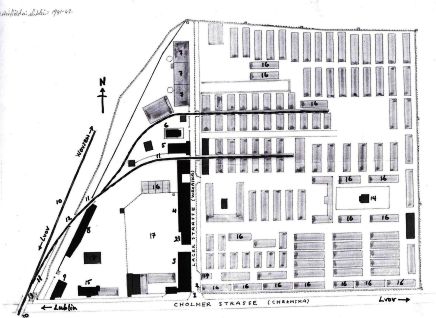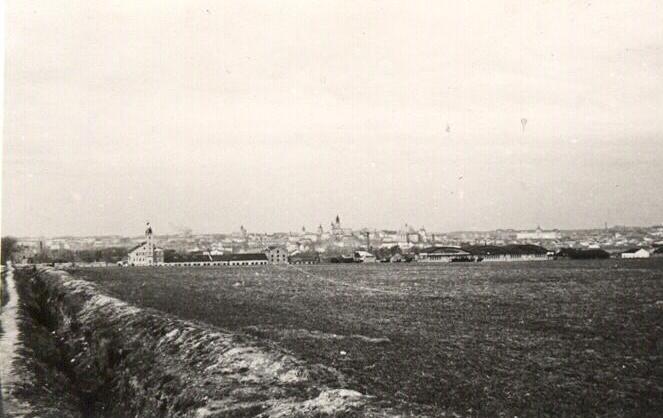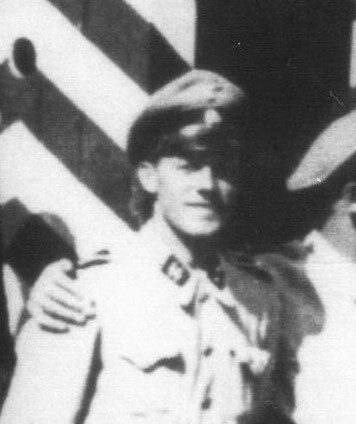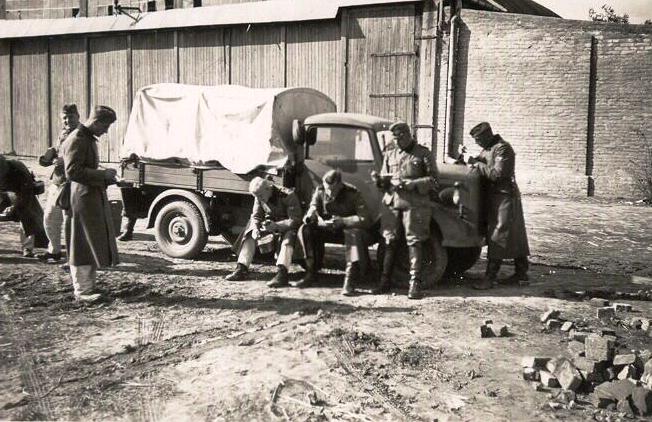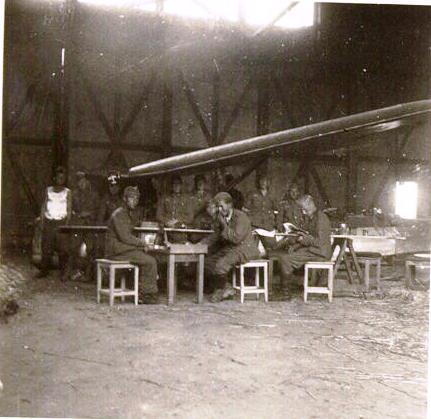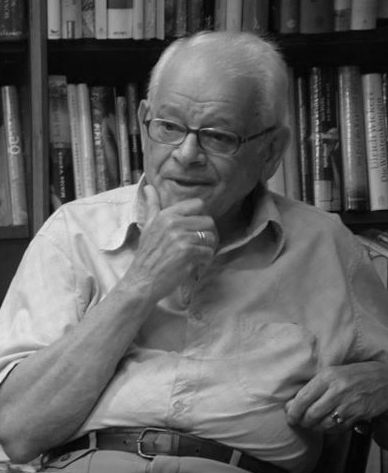Holocaust Education & Archive Research Team |
|
Aktion Reinhard A-R Leadership
A-R Articles
Action Erntefest Modern Research | |||
Lublin - The Old Airfield Camp (Alter Flugplatz)
The SS Clothing Works (SS- Bekleidungswerke) was established in the summer of 1941, on the premises of the former Lublin Aircraft Factory, the so-called Plage and Laskiewicz Mechanical Plant located on Chelmska Street.
Initially women prisoners from the Lublin Castle and Jewish specialists from the Lublin ghetto were employed there. Production was developed on a large scale, because Himmler in a note dated 21 July 1941, instructed the SS storehouses to place their orders there.
In effect, the enterprise was subordinated, as of 1 September 1942, to the SS- Clothing firm as a branch. This situation lasted until March 1942, when the Clothing Works was again placed under Globocnik’s administration.
Thenceforth, the enterprise was to engage in the segregation, disinfection, and shipment to the Reich of the property of the murdered Jews, in the death camps of Aktion Reinhard.
In connection with this re-organisation and in order to conceal the true nature of the Works activities, SS- Hauptsturmfuhrer Friedrich Opitz was replaced as the works manager by SS- Hauptsturmfuhrer Josef Obermeyer, Globocnik’s trusted right-hand man.
His task was to expand, from the spring of 1942 till the spring of 1943, both the Clothing Works proper and the prisoner barracks. In the newly erected barracks Jews and Jewesses were accommodated.
Just before Christmas 1942 Christian Wirth the former Belzec death camp commandant and since 1 August 1942 the Inspekteur der SS- Sonderkommando moved into a two-storey villa on Chelmska Street, at the north-west corner of the disused Lublin airfield, and adjacent to the main Lublin- Warsaw – Lvow railway line.
The ground floor rooms were used as offices – staffed by Wirth, Oberhauser, Hausler and a couple of secretaries. On the first floor were located a first-class dining room and living quarters for Wirth and his staff.
Here at the old airfield from the commencement of the mass-murder programme three hangers had been used as the main sorting depot for the great heaps of clothing, belongings and valuables taken from the victims of Aktion Reinhard.
About 2,000 prisoners – predominantly women – were employed in sorting the plunder. The articles of clothing were sorted on arrival into kinds – men’s, women’s and children’s. Then sorted again into outer and under –wear, types of footwear. There were also big crates into which were deposited the gold, the silver, diamonds, pearls, gold watches, and other valuables.
At the end of each day, up to six men were needed to carry each crate to the Kommandantur. A great deal of the accumulated wealth was pilfered daily.
Oberhauser who worked at the Kommandantur recalled that:
“The unregistered jewellery and valuables from the individual death camps were delivered to the SS- Verwaltungsamt, whose head was SS- Sturmbannfuhrer Georg Wippern. I had not the slightest thing to do with this.”
In 1942 the DAW Company opened a tar-paper factory behind Wirth’s villa and beyond that a railway siding led from the main tracks into the depot. The wagonloads of plunder from the death camps arrived at the siding and after unloading, sorting and cleaning were despatched again by rail to the Reich.
This too was one of Oberhauser’s responsibilities:
“At the office on the airfield I was Wirth’s representative insofar as he was responsible for the supervision and welfare of the Jews employed in the clothing workshops. I had the task of organising the transports of materials being taken away, and looking after the arriving transports of materials.”
The loading work at the railway siding was carried out initially by 20 Polish- Jewish Prisoners of War from the DAW labour camp on Lipowa Street in Lublin. They were supervised by SS- Rottenfuhrer Ernst Gollack, who also supervised the disinfection of quality clothing.
“Furs and skins from the Jews at the Belzec, Sobibor and Treblinka extermination camps were disinfected there and sent to Germany. These articles arrived by rail in goods wagons, were unloaded by the “Hiwis” – and later on unloaded only by work-Jews – disinfected and re-loaded into the goods wagons. (Hiwis – German term used for Russian volunteers)
I was employed at the clothing depot as a disinfector and was in charge of about 20-30 Jewish women who were also trained as disinfectors.”
The disinfection work was carried out in a segregated section of the depot in special chambers using Zyklon – B, a special preparation of hydrocyanic acid. These chambers were also used on occasions to kill prisoners no longer fit for work. With the arrival in spring 1943 of SS- Hauptscarfuhrer Lorenz Hackenholt, the Belzec gassing expert, there can be little doubt he was active in the gassing of these prisoners.
In the spring of 1942 the airfield was divided into a men’s and a women’s compound, segregated by a high plank fence with the entrances at opposite ends. The prisoners’ work day lasted from 0800 – 1800, with a midday break, according to SS-Sturmbannfuhrer Georg Michalsen of Globocnik’s staff:
“The camp management was in Jewish hands – there was a Jewish camp police, and in addition in certain circumstances those Jews who had special passes could buy goods they needed in Lublin and its environs.” Until the arrival of Wirth and his staff, the camp had been run by SS - Hauptsturmfuhrer Josef Obermeyer, assisted by his deputy Heinrich Birmes.
Wirth and Obermeyer took an instant dislike to one another, Wirth did not approve of the way the camp was being run, and Obermeyer loathed the way Wirth treated the Jewish workers.
Wirth was very much feared by the Jewish workers, because of his penchant for riding round the camp on horseback – even entering the barracks and workshops – brandishing a whip on which there was a piece of barbed-wire, according to the statements of Ernst Gollack..
SS- Oberscharfuhrer Bauer from Sobibor death camp who visited Wirth at the Old Airfield witnessed an example of Wirth’s brutal treatment of the Jewish workers at the tar-paper factory.
Wirth was personally supervising the work:
“I myself have seen and remember for certain how the Jews employed there were pouring fresh hot tar onto the pasteboard with bare hands. I also saw the raw flesh peeled from their fingers so that the bare bones could be seen. I am convinced that all these people died of their bad burns. I remember this work with the tar-paper so well because I was upset by it at the time and Wirth hit me in the face with his whip.”
Wirth began re-organising the camp at the end of December 1942 by sending all the male prisoners to the nearby Majdanek concentration camp, and re-naming the depot – The Used Materials Administration Depot of the SS Administration Office Lublin, thus bringing it directly under the control of SS- Sturmbannfuhrer Georg Wippern.
Wirth then personally selected a new Jewish work-force from the next incoming transport according to their skills. The selections were carried out on the main railway tracks just outside the depot, the remainder of the transport Wirth sent on to Majdanek camp.
Selections were frequent and this account from the unpublished memoirs of Wieslaw Dobrowolski describes one such selection:
“Every fortnight – sometimes more frequently – a selection was carried out in the camp. On such occasions a group of SS- men arrive from Majdanek to conduct the selection. We had to line up on the asphalt road.
On the same road, about 50 meters away from us, right by the main entrance to the camp, the group of SS-men gathered. At a sign from the SS-men, 3 -4 prisoners were ordered to run towards the gate.
The men who ran tolerably well were placed on the right of the road, while those whose legs refused to carry them properly were ordered to stand on the left.
There were always a few dozen who were sorted out and escorted to barrack number 5. This was the so-called “gas barrack” which served as a disinfection chamber for furs. The people selected were gassed in this barrack.
I was a witness when Wolanow, the very popular owner of an office selling State Lottery tickets, was selected and pushed into the “gas barrack”.
The shrieks and cries spread far and wide beyond the “gas barrack”. When Wolanow’s 17-year old son, who was standing nearby, heard the cries he was seized by a fit and cried spasmodically.”
The old Lublin airfield was also used throughout Aktion Reinhard as a mustering cente for personnel transferred from the euthanasia institutes in the Reich- members of the SS, police, male nurses – to staff the Aktion Reinhard extermination camps in Poland.
They were usually met by Wirth personally, on occasions accompanied by Reichleitner from Sobibor and Stangl from Treblinka. According to witnesses, at these personnel selections, all three commanders wore the uniforms of Schutzpolizei officers, and none of them mentioned anything about which units they were joining, or where they were to be based.
The male nurses among them – referred to now by Wirth and others as “civilians in uniforms” were first sent to the SS training camp at Trawniki, near Lublin, on a two-week basic militahry training course.
Between January 1943 and spring 1943, a number of Aktion Reinhard personnel were transferred from the death camps to serve at the old Lublin airfield, either because they were now redundant, or as a disciplinary measure.
Among the disciplinary cases were SS- Oberscharfuhrer Kurt Bolender from Sobibor and SS- Stabsscharfuhrer Otto Stadie from Treblinka. Bolender was attached to Lorenz Hackenholt’s work-brigade, and Stadie was placed in charge of the 120-strong Trawniki –SS guard unit at the old airfield.
In February 1943, following the establishment of Ost- Industrie GmbH (Osti) – East Industry Company, the company managed by Globocnik to utilise Jewish labour, was again subordinated to Globocnk, as the director of the company until its liquidation on 3 November 1943.
Jakob Sporrenberg who took over from Globocnik as SSPF Lublin described a visit to the On the 3 November 1943 the old airfield site was cordoned off by SS and Police forces, including members of Police Regiment 25, which included members of Police Battalion 101, and the prisoners marched the short distance to nearby Majdanek concentration camp where they were shot in specially prepared ditches, behind the new crematorium.
The camp was liquidated on this day, and Wirth joined Globocnik in Italy. One of the few survivors from the Alter Flugplatz told his story:
Jules Schelvis at Alte Flugplatz Lublin
Amsterdam born Jules Schelvis -seized from his house on 103, Nieuwe Kerkstraat near the ‘Meagre Bridge’ over the Amstel River, in a big round up on 26 May 1943,- was deported to Westerbork that same day, and from there to Sobibor on 1 June. Three days later his wife Rachel, her parents and sisters were gassed there on arrival. Jules was selected in the Sobibor reception area to work in the peat diggers camp at Dorohucza on the River Wieprz.
After nine days in Dorohucza, he and two other Dutch Jews, -Joop Wins and Leo de Vries,- were selected again, because of their knowledge of the German language, and sent further to the Alter Flugplatz (Old Airfield) camp, between Lublin centre and the Majdanek Concentration Camp, south east of the city.
But instead of work in a printing office, as they had been promised, they were forced to help building new barracks for prisoners. SS men whipped the slave labourers all the time, shouting: “Schneller, schneller, prentko, dalli dalli”. Living conditions in the camp were almost indescribable. Hordes of lice covered the mattresses and everywhere in the sleeping barracks were heaps of human excrements.
Some of the exhausted slave workers lay dying in the bunks, no longer aware of anything; the so called ‘mussulmen’. The food consisted of little more than brown water (‘soup’). Inmates sold or exchanged everything they had for extra food: e.g. one’s pants, belt or a knife for a piece of bread and some butter, somehow smuggled into the camp. A loaf of bread cost 350 zlotys, 50 grams of butter 50 zlotys.
The prisoners were tortured in a very sadistical way. At the Appellplatz, on the command “Mützen ab! Mützen auf!” they had to take off and put on their caps simultaneously. When the SS officer was not satisfied with the result, the prisoners were beaten and those who could not keep up to speed, were forced to do all kinds of gymnastic exercise. Whips and rifle butts were used to speed up the victims. The other prisoners had to watch the scene.
They were also forced to watch the hanging of two inmates who had tried to escape; a young Pole and the Dutch Jew Jim Kleerekoper, who had been forced to build up their own gallows.
This “ceremony” was supervised by SS Untersturmführer Wolfgang Mohwinckel, sitting proudly on the back of a white horse. The hangman was a Volksdeutsche by the name of Schmidt. [Mohwinckel was rewarded with a Kriegsverdienstkreuz by the Führer, but sentenced to life time imprisonment in 1974. The following days Jules and the other men from Dorohucza were sent to the hall of a former radio factory, to clean machines. There, the prisoners possessed a Russian radio which broadcasted Soviet military news.
Sometimes men in the radio factory were commanded to the building sites or to demolish old barracks. Jules’ friend Joop Wins, also a member of the Dorohucza printers group, found a $ 20 bill, hidden behind a loose shelf. One US dollar had a rate of 600 zlotys in the camp at the time. This fortune kept the group in better condition during several days.
On the 14th day of their stay at Alter Flugplatz, 27 June 1943, the camp was visited by a man named Seifert, commander in the OSTI-organization. He was accompanied by Marian Winogrodski, a Jew, who was to take command of the SS printing office in the town of Radom.
One hundred men from the Alter Flugplatz camp were selected for this office, including the three Dutchmen. Most of the others were Jews and Jewesses from Warsaw. The next day they were put on the train consisting of two freight wagons, to Radom.
… and how he survived the Holocaust.
Jules Schelvis stayed in the printing office in the Radom ghetto until early November 1943, when he was interned in a new nearby camp at Szkolna. There he stayed until 26 July 1944. A march to Lodz (Litzmannstadt) was planned, but at three quarters into that journey at Tomaszow, the survivors were put on a train to Auschwitz.
At the famous Rampe Jules was selected again for slave labour, this time the building of a secret underground Messerschmidt airplane factory of Organisation Todt near Vaihingen an der Enz in southwestern Germany, -originally an Außenlager of Natzweiler Concentration Camp in the Alsace,- where he arrived on 12 August 1944.
In November 1944 Jules was sent to a camp in Unterriexingen, 10 miles from Vaihingen and some 20 miles NW of Stuttgart. In Unterriexingen he got ill with a foot infection and taken into the infirmary barrack; there he was infected with typhus.
Jules Schelvis was evacuated from Unterriexingen in March 1945, although not to Dachau with the prisoners considered still able to work, but back to Vaihingen, which meanwhile had been converted into a recovery camp (“Erhohlungslager”). There he was liberated on 8 April 1945 by French troops, exactly one month before the capitulation of Nazi Germany.
Leo de Vries and Joop Wins had been together with Jules as “die drei Holländer” almost until the end. The two were put on a transport from Unterreixingen to Dachau Concentration Camp, which in fact took weeks to arrive there.
Leo died during the transport. Joop survived Dachau and was reunited with Jules in Amsterdam in early July 1945.
Sources: Unpublished Report – Mike Tregenza (Including Map of the Lublin Airfield Camp) Jules Schelvis – “Binnen de Poorten” (Inside the Gates: a report of two years in German extermination- and concentration camps) by Jules Schelvis – published in the 7th completely reviewed edition, - ed. De Bataafsche Leeuw, Amsterdam 2003. Majdanek by Josef Marszalek, published by Interpress 1986 Holocaust Historical Society
Copyright Victor Smart – H.E.A.R.T 2008
|
